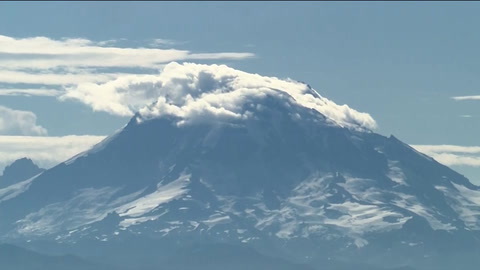Could Mount Rainier Be an Immediate Threat?

Mt. Rainier venting
October 7, 2022
The Cascade Mountain Range is home to tall mountains and luxurious evergreen forests. The Cascades stretch across the northwestern part of the United States, going from Southern British Columbia all the way down to Northern California. While the range has its non-volcanic mountains, it also has its volcanic mountains. This range of volcanic mountains has produced the majority of volcanic eruptions in the Pacific Ring of Fire. Some of the most well known mountains in the Cascades include Mount Baker, Mount Shasta, Mount Hood, and Mount Rainier. Out of those, Mount Hood and Mount Baker have been active or have had some sort of activity in recent years. Recently, there has been speculation that Mount Rainier is venting. Although Rainier has not had an eruption in 500 years, scientists have declared it to not be an immediate threat.
Mount Rainier is located in Ashford, Washington, has an elevation of 14,411ft and is one of the tallest mountains in the Cascades. However, Mount Rainier is an active mountain and has been rumored to be venting in the past weeks. People have claimed that steam has been venting out from it. This statement has led people to believe Mount Rainier is going to erupt, even though Rainier has not erupted in many years. Scientists say that it is not going to erupt any time in the near future. The United States geological survey looked into the unusual activity and declared that it was just a cloud over the mountain. When the agency spoke about this they said “After looking at the data we collected, the USGS seismic network does not show any unusual levels of activity coming from mount Rainier.” Webcams in the park did end up capturing how this cloud above the peak formed, the moisture rich air made its way up the summit and as the air cooled to its dew point the moisture condensed and formed the cloud that poured right over the edge of the mountain causing it to appear as if the mountain was venting.
As scientists have said that the mountain is not venting, that does not mean the volcano is not active. Rainier has 25 major glaciers, which is a significantly higher amount than any other mountain range in the Cascades. If even a small part of the ice and snow from the glaciers were to melt from volcanic activity, it would cause potentially dangerous mudflows. The enormous glacier mantle is not the only concern when it comes to the activity of Rainier, if the mountain were to erupt, it would be even greater than when Mount St. Helens erupted in the 1980s. It is possible that lava flows would reach Seattle, but even then the ash that would fall from the sky would cause the biggest problem. The volcanic ash would contaminate the city’s drinking water supply and would be heavy enough to make roofs cave in.
Even though right now Mount Rainier is a sleeping volcano that has the possibility of erupting, people should not be worried about the mountain venting. The USGS has been working on installing new monitoring systems and if any volcanic activity is detected, the public will be informed on what to do then.





